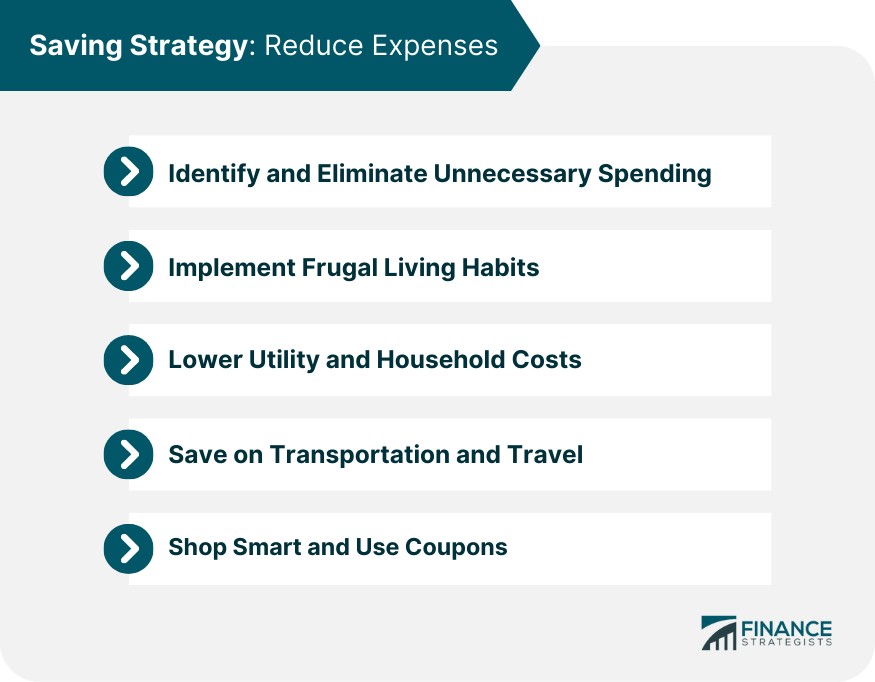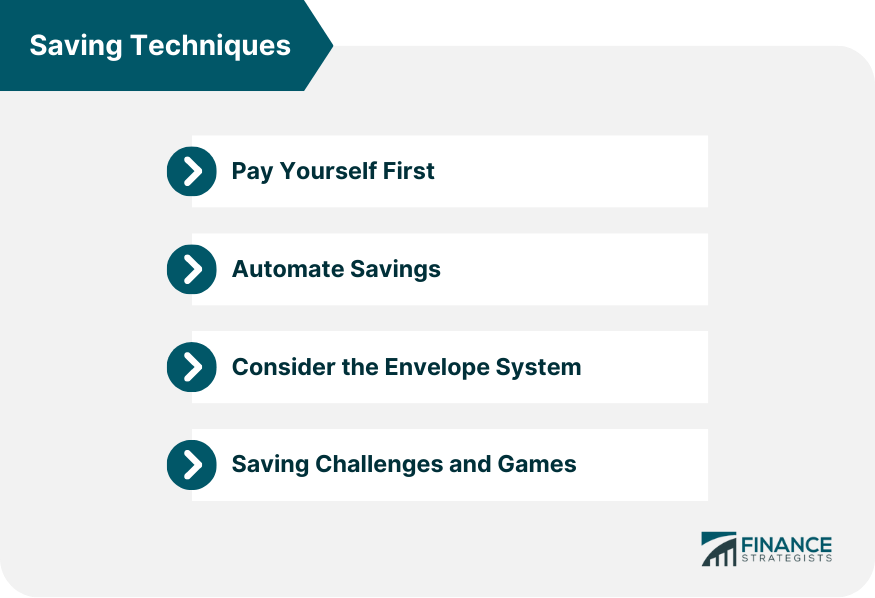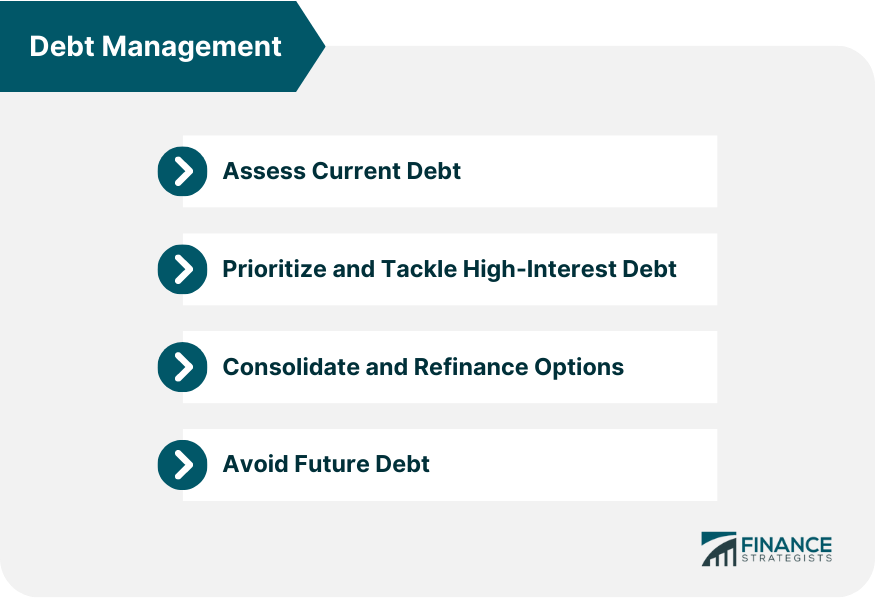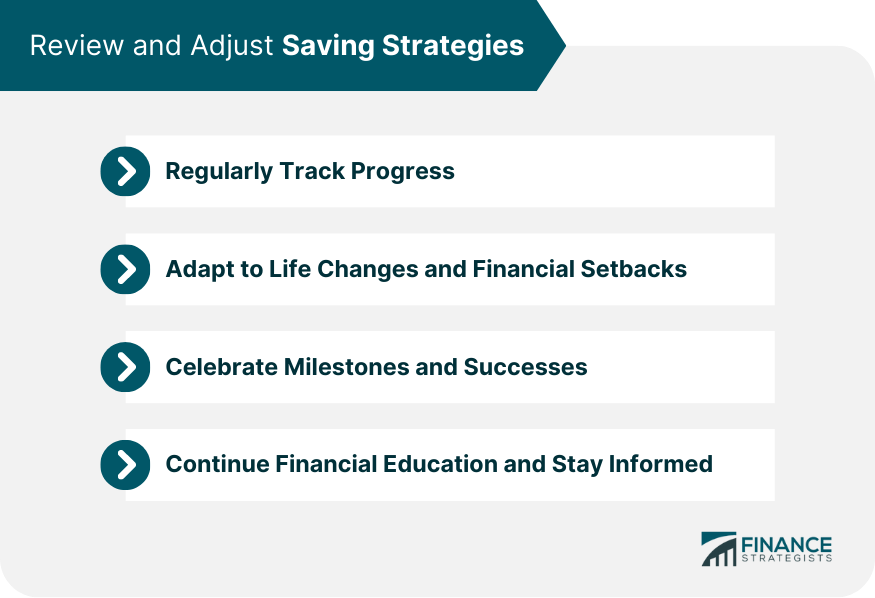Saving strategies are financial plans designed to help individuals accumulate wealth and achieve financial goals by systematically setting aside a portion of their income. These strategies often involve budgeting, reducing expenses, and increasing income to create a balanced financial plan. Saving money is essential for achieving financial stability and security. By consistently saving, individuals can prepare for unexpected expenses, reduce financial stress, and work towards long-term goals such as buying a home, starting a business, or retiring comfortably. Implementing saving strategies helps individuals establish clear financial goals, develop discipline in managing their money, and ultimately achieve a greater sense of financial well-being. By following a well-structured plan, individuals can work towards financial independence and a more secure future. Short-term financial goals are objectives that can be achieved within a year, such as paying off credit card debt, building an emergency fund, or saving for a vacation. Focusing on short-term goals can provide motivation and a sense of accomplishment, helping to build momentum toward long-term financial success. Medium-term goals typically have a timeframe of one to five years and may include saving for a down payment on a home, starting a business, or furthering one's education. Achieving these goals often requires a combination of disciplined saving and strategic planning. Long-term financial goals are those that take more than five years to achieve, such as funding a child's education, paying off a mortgage, or retiring comfortably. These goals often require consistent saving, investing, and a long-term commitment to financial discipline. Prioritizing financial goals is essential to ensure that individuals focus their efforts and resources on the most important objectives. By ranking goals based on their urgency, personal values, and potential impact, individuals can create a roadmap for achieving financial success. A crucial step in creating a budget is tracking one's income and expenses. This helps individuals understand their financial situation, identify spending patterns, and make informed decisions about how to allocate their money. Categorizing spending is essential for creating a clear picture of where money is going. By dividing expenses into categories such as housing, groceries, and entertainment, individuals can identify areas where they may be overspending and make adjustments accordingly. Establishing spending limits for each category helps individuals maintain financial discipline and prevent overspending. By setting realistic limits, individuals can work towards their financial goals while still enjoying their desired lifestyle. Regularly evaluating and adjusting the budget is essential for ensuring that it remains effective and relevant. By reviewing spending habits and financial goals, individuals can make necessary adjustments to stay on track and achieve financial success. Budgeting tools and apps can streamline the budgeting process, making it easier for individuals to track their income and expenses, set spending limits, and monitor their progress. By utilizing technology, individuals can simplify their financial management and stay focused on their goals. Identifying and eliminating unnecessary spending is a critical aspect of reducing expenses. By scrutinizing spending habits, individuals can find areas where they can cut back without significantly impacting their quality of life. Frugal living habits involve finding ways to save money and live more efficiently. By adopting practices such as cooking at home, reducing energy consumption, and repurposing items, individuals can significantly lower their expenses and increase their savings. Reducing utility and household costs can lead to substantial savings over time. Strategies for lowering these costs may include using energy-efficient appliances, insulating the home, and negotiating better rates with service providers. Transportation and travel expenses can be reduced by utilizing public transportation, carpooling, or biking instead of driving. Additionally, planning vacations during off-peak seasons and researching deals can help save money on travel. Being a savvy shopper and using coupons can lead to significant savings on everyday purchases. By comparing prices, buying items in bulk, and utilizing discounts, individuals can stretch their budgets and allocate more money toward their financial goals. Negotiating salary increases is an important strategy for boosting one's income. By demonstrating their value to an employer and researching industry salary benchmarks, individuals can advocate for a fair and competitive wage. Side hustles and freelance work can provide additional income streams, helping individuals reach their financial goals more quickly. Pursuing opportunities that align with one's skills, interests, and schedule can lead to a sustainable and lucrative supplementary income. Investing in education and skills development can help individuals secure higher-paying jobs or advance in their current careers. By pursuing certifications, degrees, or specialized training, individuals can increase their earning potential and achieve greater financial success. Passive income streams, such as rental properties, dividend-paying stocks, or online businesses, can provide ongoing income with minimal effort. By diversifying income sources and building passive income streams, individuals can increase their financial stability and work towards long-term financial goals. Paying yourself first means prioritizing savings by allocating a portion of your income to your financial goals before spending on other expenses. This approach ensures that saving becomes an integral part of your financial plan, helping you consistently work towards your objectives. Automating savings involves setting up recurring transfers from your checking account to a designated savings or investment account. By automating this process, individuals can eliminate the need for manual transfers and ensure that saving remains a consistent and effortless habit. The envelope system is a budgeting technique that involves allocating cash for various spending categories and placing the money in separate envelopes. This method helps individuals maintain control over their spending, as they can visually see how much money remains in each category, preventing overspending. Saving challenges and games are fun, engaging ways to motivate individuals to save money. Examples include the 52-week saving challenge, no-spend challenges, and rounding up purchases to the nearest dollar. These games can help make saving more enjoyable and encourage healthy financial habits. An emergency fund is a savings account specifically designated for unforeseen expenses, such as medical emergencies, car repairs, or job loss. This fund provides a financial safety net, preventing individuals from relying on high-interest debt or compromising their long-term financial goals during difficult times. The ideal amount for an emergency fund varies depending on an individual's financial situation and needs. Generally, it is recommended to have three to six months' worth of living expenses saved. Factors such as job stability, family size, and monthly expenses should be considered when determining the appropriate amount. Building and maintaining an emergency fund involves consistently setting aside money until the target amount is reached. Once established, the fund should be periodically reviewed and adjusted as necessary to account for changes in income, expenses, or financial goals. Assessing current debt involves creating a comprehensive list of all outstanding debts, including balances, interest rates, and monthly payments. This information is crucial for developing a strategic plan to pay off debt and achieve financial freedom. Focusing on paying off high-interest debt first can save individuals a significant amount of money in interest payments. By allocating extra funds towards these debts, individuals can reduce their overall financial burden and work towards becoming debt-free more quickly. Consolidating and refinancing the debt can help individuals simplify their financial situation and potentially secure lower interest rates. By combining multiple debts into a single loan or renegotiating loan terms, individuals can potentially reduce their monthly payments and pay off debt faster. Avoiding future debt involves maintaining financial discipline, adhering to a budget, and building a strong foundation of savings. By developing healthy financial habits and resisting the temptation to rely on debt, individuals can work towards lasting financial stability. Before investing, individuals should assess their risk tolerance and establish clear investment goals. Understanding one's risk tolerance and objectives helps guide investment decisions, ensuring that individuals select appropriate investment vehicles that align with their financial goals and comfort level. Diversifying investments involves spreading money across various asset classes, such as stocks, bonds, and real estate, to minimize risk. A well-diversified portfolio can help protect individuals from market volatility and provide more consistent returns over time. Low-cost index funds and ETFs are popular investment vehicles that track market indices, providing broad market exposure at a low cost. These investments are generally passive, require minimal management, and offer an accessible way for individuals to participate in the market's growth over time. Dollar-cost averaging involves consistently investing a fixed amount of money at regular intervals, regardless of market conditions. This strategy helps reduce the impact of market fluctuations, lowers the risk of poor investment timing, and encourages disciplined, long-term investing. Retirement savings plans, such as 401(k)s, IRAs, and Roth IRAs, provide individuals with tax-advantaged ways to save for retirement. By contributing regularly to these plans, individuals can benefit from compound interest, tax savings, and employer matching programs, helping them achieve their retirement goals. Regularly tracking progress is essential for ensuring that saving strategies remain effective and aligned with financial goals. By monitoring their progress, individuals can identify areas where adjustments may be necessary and celebrate their successes along the way. Life changes and financial setbacks can impact one's financial situation and goals. Adapting to these changes may involve adjusting saving strategies, reevaluating financial goals, or seeking professional guidance to navigate new challenges. Celebrating milestones and successes can provide motivation and reinforce the benefits of disciplined saving. Acknowledging achievements, whether large or small, can help individuals maintain momentum and stay committed to their financial goals. Continuing financial education and staying informed about personal finance topics are crucial for maintaining and improving one's financial health. By regularly seeking out new knowledge and staying updated on financial trends, individuals can make more informed decisions and adapt their strategies as needed. Effective saving strategies can provide numerous benefits, including greater financial security, reduced stress, and the ability to achieve personal financial goals. By implementing these strategies, individuals can work towards a brighter financial future and enjoy the rewards of their discipline and commitment. Consistency and discipline are key to the success of any saving strategy. By maintaining a steady approach and adhering to their plans, individuals can overcome setbacks, build healthy financial habits, and ultimately achieve their financial goals. A secure financial future is built on a foundation of disciplined saving, prudent spending, and wise investing. By employing effective saving strategies, individuals can create a stable financial base, allowing them to pursue their dreams and enjoy a comfortable lifestyle. For those seeking further guidance or facing complex financial situations, working with a financial advisor can be beneficial. A financial advisor can provide personalized advice, help individuals navigate financial challenges, and ensure that their saving strategies align with their unique financial goals and circumstances.What Are Saving Strategies?
Setting Financial Goals
Short-term Goals
Medium-term Goals
Long-term Goals
Prioritizing Goals
Budgeting
Creating a Budget
Tracking Income and Expenses
Categorizing Spending
Setting Spending Limits
Evaluating and Adjusting the Budget
Utilizing Budgeting Tools and Apps
Reducing Expenses

Identifying and Eliminating Unnecessary Spending
Implementing Frugal Living Habits
Lowering Utility and Household Costs
Saving on Transportation and Travel
Shopping Smart and Using Coupons
Increasing Income
Negotiating Salary Increases
Pursuing Side Hustles and Freelance Work
Investing in Education and Skills Development
Passive Income Streams
Saving Techniques

Paying Yourself First
Automating Savings
The Envelope System
Saving Challenges and Games
Emergency Funds
Purpose of an Emergency Fund
Determining the Ideal Amount
Building and Maintaining the Fund
Debt Management

Assessing Current Debt
Prioritizing and Tackling High-Interest Debt
Consolidating and Refinancing Options
Avoiding Future Debt
Investing Strategies
Understanding Risk Tolerance and Investment Goals
Diversifying Investments
Low-Cost Index Funds and Exchange-Traded Funds (ETFs)
Dollar-Cost Averaging
Retirement Savings Plans
Reviewing and Adjusting Saving Strategies

Regularly Tracking Progress
Adapting to Life Changes and Financial Setbacks
Celebrating Milestones and Successes
Continuing Financial Education and Staying Informed
Final Thoughts
Saving Strategies FAQs
Effective saving strategies include setting financial goals, creating a budget, reducing expenses, increasing income, paying oneself first, automating savings, utilizing the envelope system, and building an emergency fund.
An emergency fund provides a financial safety net in case of unexpected expenses, such as job loss, medical emergencies, or car repairs. Having an emergency fund ensures that individuals do not have to rely on high-interest debt or compromise their long-term financial goals during difficult times.
Ways to increase income include negotiating salary increases, pursuing side hustles and freelance work, investing in education and skills development, and building passive income streams.
Individuals should regularly track their progress, adapt to life changes and financial setbacks, celebrate milestones and successes, and continue their financial education to stay informed and up-to-date with the latest trends and strategies.
Tips for effective debt management include assessing current debt, prioritizing and tackling high-interest debt, consolidating and refinancing options, and avoiding future debt by building healthy financial habits and adhering to a budget. By tackling debt effectively, individuals can reduce their overall financial burden and work towards achieving their long-term financial goals.
True Tamplin is a published author, public speaker, CEO of UpDigital, and founder of Finance Strategists.
True is a Certified Educator in Personal Finance (CEPF®), author of The Handy Financial Ratios Guide, a member of the Society for Advancing Business Editing and Writing, contributes to his financial education site, Finance Strategists, and has spoken to various financial communities such as the CFA Institute, as well as university students like his Alma mater, Biola University, where he received a bachelor of science in business and data analytics.
To learn more about True, visit his personal website or view his author profiles on Amazon, Nasdaq and Forbes.











